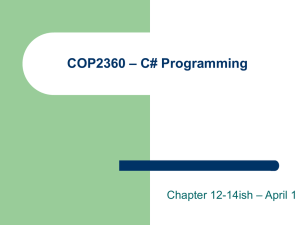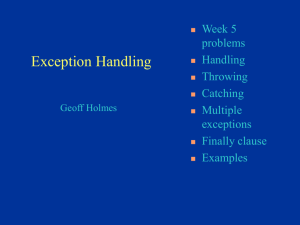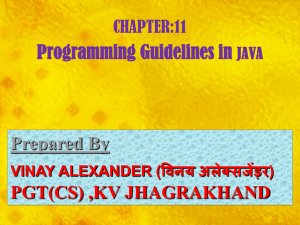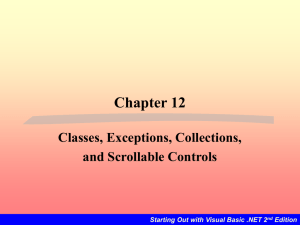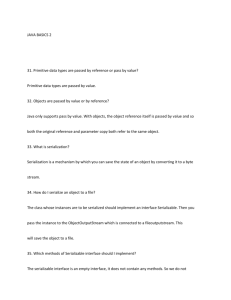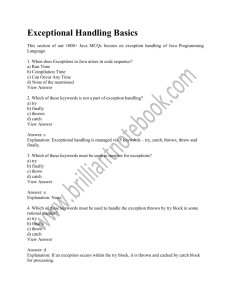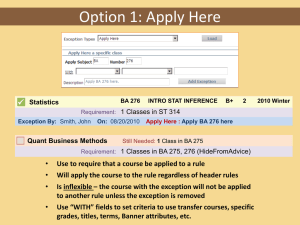powerpoint 10
advertisement
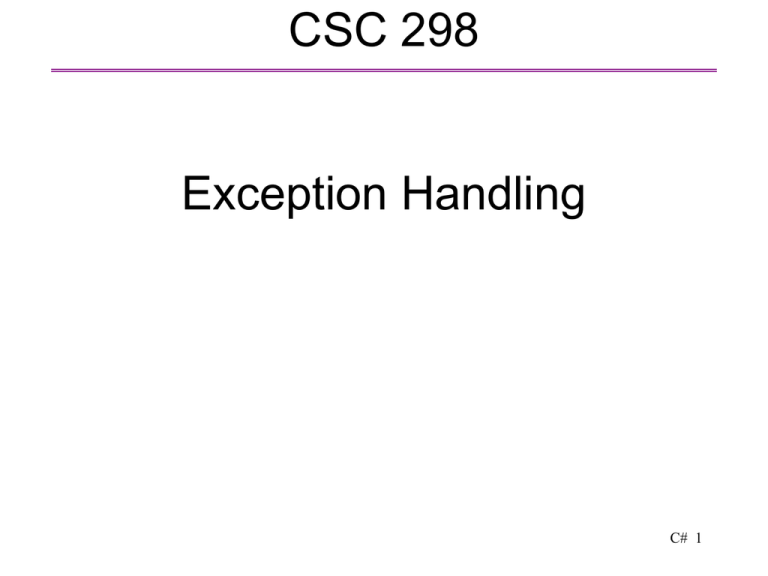
CSC 298
Exception Handling
C# 1
Motivation
We want to prevent our program from giving wrong
answers or worse crashing.
Standard approach: check any values used for a
computation (e.g., is the grade between 0 and 4?)
However, sometimes, we have no control over
circumstances that might affect our program
What if the disk drive fails while writing to it?
Exception handling: a facility to allow the
programmer to
insert code to handle unexpected errors
allow the program to recover and continue executing,
or terminate gracefully.
C# 2
throw statement
Use a throw statement to signal to the user an
abnormal condition
e.g.
public double Sqrt(double x)
{
if (x<0)
throw new ArgumentException(
"Negative value x=" + x);
else
// Note: Math.Sqrt(-10) is NaN
return Math.Sqrt(x);
}
C# 3
try – catch statement (1)
Enclose in a try block any code that might throw
an exception. If an exception is thrown, the
control flow is transferred to the appropriate
catch block following the try block.
catching an exception
try
{
Console.WriteLine(Sqrt(-10));
}
catch (ArgumentException ae)
{
Console.WriteLine(ae.Message);
}
C# 4
try and catch (2)
Write in the try block the code that might throw
exceptions (different types of exception might
be thrown).
Write in one or more catch clauses the code to
handle the exceptions
try{
//statements that might throw exceptions
}
catch(ExceptionType1 e1){/*handling code*/}
catch(ExceptionType2 e2){/*handling code*/}
What if the type of the exception is not listed in
the catch clauses?
What happens once we are done with the
C# 5
catch clause?
Control flow for exceptions
When an exception is thrown in a try block
the control flow goes to the first catch block
listed after the try block that matches the
exception type (same class or a superclass)
Once done with the catch clause, execution
resumes with the first statement after the list of
the catch blocks. Execution doesn't go back in
the try block.
If no matching catch is found in the method, the
CLR looks for a matching catch in the caller of
the method. The process goes on until a catch
is found.
If no catch is found, the program or thread
C# 6
aborts.
catch { }
Don't use any argument in the catch to catch all
exceptions (but don't get any information about
the exception)
try{
//statements that might throw
//exceptions
}
catch { /*all exceptions are caught here*/ }
Always write catch blocks from the most specific
to the least specific (catch {} should always be
last).
C# 7
finally statement
Sometimes some operations must be done
before leaving a method (e.g. closing a
connection to a database). What if the code
leaves abruptly the method by throwing an
exception?
Code written within a finally block is always
executed (whether an exception is thrown or not)
try{}
catch (...){}
finally{ /* always done */ }
C# 8
Exception classes
Check "exceptions, hierarchies" (within the help index of
Visual studio).
Exception class: base class of all exceptions.
Some properties of exception objects
Message: a String describing the exception
StackTrace: a String that the chain of calls on the stack
when the exception was thrown.
InnerException: it may be possible to wrap an exception
within an exception (e.g. when rethrowing an exception)
catch(ExceptionType1 e1){
ExceptionType2 e2 = new ExceptionType2
("message", e1); //if such constructor
// e2.InnerException is e1
throw e2;
}
C# 9
Creating your own exceptions
Extend the ApplicationException class and add
your own custom methods and properties.
ApplicationException is never thrown by the
CLR (allows to differentiate between exceptions
thrown by the system, and exceptions thrown
by a user program).
C# 10

